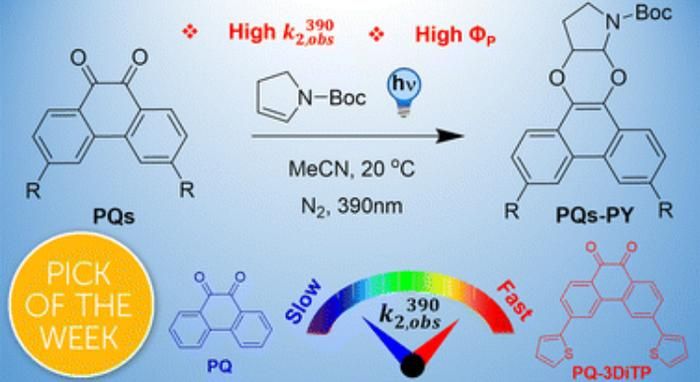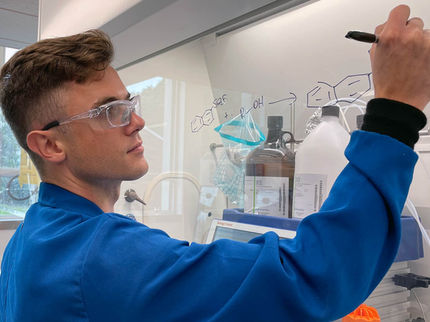Taking photoclick chemistry to the next level
A boost for the PQ-ERA photoclick reaction
In a cooperation between the Universities of Groningen and Amsterdam (The Netherlands) and the European Laboratory for Non-Linear Spectroscopy (Italy), researchers have been able to substantially improve photoclick chemistry. They were able to boost the reactivity of the photoclick compound in the popular PQ-ERA reaction through strategic molecular substitution. In Chemical Science, the flagship journal of the Royal Society of Chemistry, they report a superb photoreaction quantum yield, high reaction rates and notable oxygen tolerance. The paper was designated a HOT Article as well as Pick of the Week.

UvA HIMS / ChemSci
At the University of Amsterdam, Michiel Hilbers and Wybren Jan Buma of the Molecular Photonics group (Van ’t Hoff Institute for Molecular Sciences) contributed to the research of which the synthetic and reaction characterization part was conducted in the laboratories of Wiktor Szymanski and Nobel laureate Ben Feringa at the University of Groningen.
Photoclick chemistry is a light-activated variety of click chemistry (Nobel Prize in Chemistry 2022), a set of elegant and efficient chemical reaction methods that couple dedicated molecular units to yield desired products. Photoclick chemistry has unique advantages over conventional click chemistry as it allows for a high degree of both spatial and temporal control over the reaction. It has a broad range of applications, including 3D printing, protein labelling, and bioimaging.
A boost for the PQ-ERA photoclick reaction
A specific photoclick reaction is the so-called PQ-ERA reaction - the light-induced photocycloaddition of 9,10-phenanthrenequinone (PQ) with electron-rich alkenes (ERA). It has drawn much attention because of its excellent kinetics and biocompatibility. However, the conventionally used PQ compounds show limited reactivity, which hinders its overall efficiency.
In the study now presented in Chemical Science, the international research team presents a simple strategy to change that. They describe how a thiophene substitution at the 3-position of the PQ scaffold significantly boosts the reactivity of the PQ triplet state to enhance the efficiency of the PQ-ERA reaction. Nanosecond time-resolved spectroscopic studies and quantum chemical studies in the Amsterdam Molecular Photonics group combined with femtosecond time-resolved spectroscopic studies performed in Florence provided a fundamental understanding of this specific photoclick chemistry. The investigations show that the substitution significantly increases the population of the reactive triplet state (3ππ*) during excitation of 3-thiophene PQs. This results in a superb photoreaction quantum yield (FP, up to 98%), high second order rate constants (k2, up to 1974 M−1 s−1), and notable oxygen tolerance for the PQ-ERA reaction system.
These results now pave the way for a further improvement of the reaction, offering excellent prospects for fast and efficient photoclick transformations.
Original publication
Other news from the department science

Get the chemical industry in your inbox
By submitting this form you agree that LUMITOS AG will send you the newsletter(s) selected above by email. Your data will not be passed on to third parties. Your data will be stored and processed in accordance with our data protection regulations. LUMITOS may contact you by email for the purpose of advertising or market and opinion surveys. You can revoke your consent at any time without giving reasons to LUMITOS AG, Ernst-Augustin-Str. 2, 12489 Berlin, Germany or by e-mail at revoke@lumitos.com with effect for the future. In addition, each email contains a link to unsubscribe from the corresponding newsletter.




























































